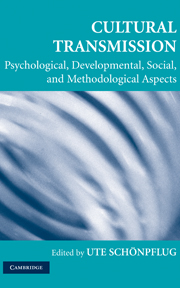Book contents
- Frontmatter
- Contents
- Foreword
- Contributors
- 1 Introduction to Cultural Transmission: Psychological, Developmental, Social, and Methodological Aspects
- 2 Theory and Research in Cultural Transmission: A Short History
- PART ONE EVOLUTIONARY PERSPECTIVE
- PART TWO CROSS-CULTURAL PERSPECTIVE
- PART THREE INTRACULTURAL VARIATIONS
- 14 Intergenerational Transmission of Moral Capital across the Family Life Course
- 15 Similarity of Life Goals in the Family: A Three-Generation Study
- 16 The Intergenerational Transmission of Xenophobia and Rightism in East Germany
- 17 Intergenerational Transmission of Violence
- 18 “Don't Trust Anyone over 25”: Youth Centrism, Intergenerational Transmission of Political Orientations, and Cultural Change
- 19 Value Transmission and Zeitgeist Revisited
- 20 Epilogue: Toward a Model of Cultural Transmission
- Index
- References
14 - Intergenerational Transmission of Moral Capital across the Family Life Course
Published online by Cambridge University Press: 05 June 2012
- Frontmatter
- Contents
- Foreword
- Contributors
- 1 Introduction to Cultural Transmission: Psychological, Developmental, Social, and Methodological Aspects
- 2 Theory and Research in Cultural Transmission: A Short History
- PART ONE EVOLUTIONARY PERSPECTIVE
- PART TWO CROSS-CULTURAL PERSPECTIVE
- PART THREE INTRACULTURAL VARIATIONS
- 14 Intergenerational Transmission of Moral Capital across the Family Life Course
- 15 Similarity of Life Goals in the Family: A Three-Generation Study
- 16 The Intergenerational Transmission of Xenophobia and Rightism in East Germany
- 17 Intergenerational Transmission of Violence
- 18 “Don't Trust Anyone over 25”: Youth Centrism, Intergenerational Transmission of Political Orientations, and Cultural Change
- 19 Value Transmission and Zeitgeist Revisited
- 20 Epilogue: Toward a Model of Cultural Transmission
- Index
- References
Summary
INTRODUCTION
The prescription to honor one's mother and father – the fifth commandment in the Old Testament – is a moral imperative found in almost all cultures of the world. However, this adage far from guarantees that children will actually feel responsible for supporting their aging parents and leaves open the question of how such obligations come into being. This can be especially problematic in developed societies where bureaucratic mechanisms may supplant kinship groups to serve basic needs of the elderly and where social change in families – such as divorce, step-parenting, and geographic separation – has produced uncertainty about the willingness and ability of adult children to fulfill their filial duties. In this chapter, we examine the intergenerational transmission of moral capital from older to younger generations as a mechanism by which responsibility to the elderly is reinforced through families. We define moral capital in terms of the internalized social norms that obligate children to care for and support their older parents, a concept at the intersection of self-interest (for parents) and altruism (for children) as viewed through the prism of sociological and economic theories of exchange.
How are we to understand the extraordinary efforts made by adult children to serve the needs of their older parents? In the absence of a strong bioevolutionary explanation for why children support their parents (as there would be in the case of parents supporting their children), one is drawn to a social explanation such as reciprocity or normative structures.
- Type
- Chapter
- Information
- Cultural TransmissionPsychological, Developmental, Social, and Methodological Aspects, pp. 317 - 337Publisher: Cambridge University PressPrint publication year: 2008
References
- 2
- Cited by



